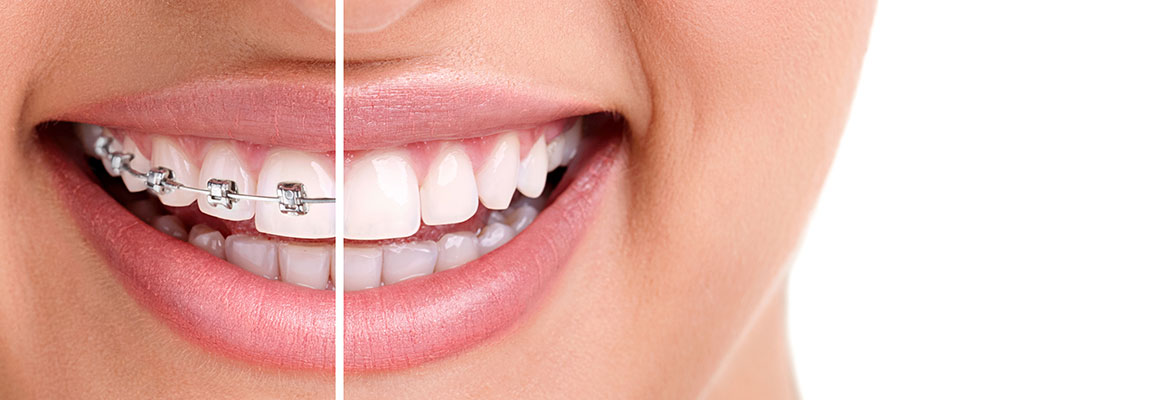
Orthodontics is a specialist branch of dentistry. It deals with the diagnosis, prevention and correction of dental and facial irregularities caused by:
- A bad bite or malocclusion
- Missing or extra teeth
- Misaligned teeth
- Crooked teeth
- Crowed teeth
- An overbite
- An under bite
- Misaligned jaw position
- A disorder of the jaw joint
You’ll all know of someone who has worn braces. This is the most common practice used in orthodontics. Braces are usually made from wires and springs attached to tiny metal plates or a plastic mould. Braces apply gentle forces to teeth and encourage them to move slowly and thereby adjust the alignment of the teeth. It’s most common to see children with braces – this is because their teeth are still growing, but these days a growing section of the population is adults who are wearing braces.
From the age of seven it is possible to begin orthodontic screening. By this age enough permanent teeth will have emerged to aid the identification of potential problems. Treatment during adolescent and teenage years is very effective because all permanent teeth will have come in. This does not mean that treatment during adulthood is not possible although at this age treatment may be more complicated.
If you have any of the following, you may be a candidate for orthodontics treatment:
- Overbite – sometimes called ‘buck teeth’ where the upper front teeth lie too far over the lower teeth.
- Under bite – a ‘bulldog’ appearance where the lower teeth are too far forward and the upper teeth too far back.
- Cross bite – when the upper teeth do not come down slightly in front of the lower teeth preventing biting together normally.
- Open bite – space between the biting surfaces of the front and/or side teeth where the teeth bite together.
- Misplaced midline – when the centre of your upper front teeth does not line up with the centre of the lower front teeth.
- Spacing – gaps, or spaces, between the teeth as a result of missing teeth.
- Crowding – when there are too many teeth for the dental ridge to accommodate.
There is large portion of the population that have misaligned or irregular teeth and jaws. When the teeth do not meet correctly, this causes strain on the jaw muscles and joints and can cause headaches and other jaw problems. Most malocclusions, or tooth problems, are inherited, though some are acquired. Acquired malocclusions can be caused by accidents, early or late loss of baby teeth, tooth decay, or sucking of the thumb or fingers over a long period of time.
Orthodontic treatment straightens or moves the teeth to improve the appearance and function. Orthodontics can also help to improve the long term health of the teeth and gums by making them easier to clean and by spreading the biting pressure evenly all over the teeth.
Orthodontics can help to improve the teeth for both health and cosmetic reasons. Misaligned teeth and jaws can cause chewing and speech problems. Severely misaligned teeth and jaws can cause snoring, sleep apnea and other breathing problems.
Orthodontic treatment usually yields the best results in children because their teeth and jaws are still growing, but adults can have orthodontic treatment too. It is recommended that every child has an orthodontic evaluation by age seven. Early intervention can make future corrections work more smoothly and quickly. Orthodontic treatment takes longer to have the desired effect in adults. Orthodontic irregularities are corrected using corrective appliances called braces and retainers. These appliances are made from wires and springs attached to small metal plates or a plastic mould. The brace applies gentle pressure to the teeth which encourages them to align differently.
When you visit your orthodontist, they will thoroughly examine your teeth and then take x-rays and plaster moulds of your teeth. The orthodontist will assess the teeth that need to be aligned and will discuss the best course of treatment with you. This will be planned with two specific phases.
In the past accelerated orthodontic treatments were solely reserved for the teens and preteens having problems. Today however, accelerated orthodontic treatments are used widely by adults.
In order to enhance your smile adults can now use different accelerated orthodontic treatments combined with various techniques like bonding, porcelain veneers, braces and crowns. While conventional braces can take years to enhance your smile, accelerated orthodontics takes only about three to eight months to give you your desired smile.
Accelerated orthodontics addresses problems with spacing, straightening and repositioning of the teeth.
The Accelerated Orthodontics Procedure
Accelerated orthodontics is a combination of different dental procedures. The procedure also involves a team of experts in the field of cosmetic surgery as well as orthodontics together to produce excellent results.
Accelerated orthodontics sometimes involves periodontal surgery too within a week from placing the braces which is usually done under local anaesthesia. There may be some discomfort for a couple of days after the procedure, but it is less painful than conventional orthodontic treatments.
Patients are likely to have an itching sensation in the gums during the treatment as the teeth start to move faster than with that of the conventional braces.
You will also need follow up ‘retainment’ sessions.
